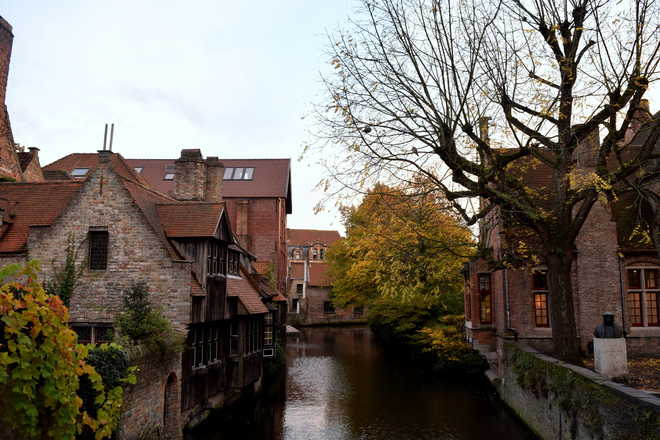Bruges, a bridge to medieval times
Akash Mehrotra
For long, Bruges has been travellers’ favourite for its romantic cobblestoned streets, dreamy canals, crooked bridges, comfortable sidewalk cafes, charming market square, and an eclectic mélange of art, culture and history. Bruges feels like an open air medieval museum. It’s tranquil but never fails to show its ambitious side, especially with young chefs exhibiting a medley of European cultures, chocolatiers setting sweeter targets, and pubs stocked with meticulously curated selections of rare Belgian beers.
The medieval wonderland
The folks in Bruges love their bicycles —almost 60 per cent of all journeys can be made on a bicycle. Or, one can take a walk along the Dijver canal through the prettiest parts of the town. The walk ends at the Markt, the main square dominated by a 13th-century belfry. The belfry has become the emblem of Bruges. One may climb its 366 stairs to have a panoramic view of the city. The Bruge square is the historical heart of Bruges. The elaborate Stadhuis (town hall) dates back to the 14th century and is among the oldest buildings in the region. At a stone’s throw from the Burge square are the Basilica of the Holy Blood and the renaissance hall of the Brugse Vrije. A little further away is Groeninge museum, housing a small but exquisite collection of the greatest of artworks of the medieval and the renaissance eras. Some striking art pieces of renaissance artists Jan van Eyck and Fernand Khnopff are housed here. For museum lovers, Bruges has a lot to offer — there is a Curious museum, the Sint-Janshospitaal museum, which once functioned as a hospital but now it’s a building of art, housing Hans Memling's detailed devotional work for his chapel. Expo Picasso at St. John hospital is another must-see art spot, where more than 300 works are housed. There is also a Volkskundemuseum (Museum of Folk Life), which gives travellers a sneak peek into everyday Flemish life of the 19th and early 20th centuries.
For its small size, Bruges houses an incredible amount of art. From local art collections to the works of the likes of Salvador Dali and Picasso, Bruges can claim to be a hub of art. Some of the greatest pieces of Jan van Eyck — The Virgin and Child with Canon Van der Paele showcasing extraordinary detailing and geometrical and spatial complexity— are housed here.
The quintessential canal trip
A good half-an-hour canal tour takes you through the bylanes of the town, secret gardens, public places, picturesque wooden or brick bridges, and old houses.
The Belgians love their chocos and chips, and Bruges has museums dedicated to both — Choco Story and the Fries Museum. Among the numerous chocolate shops, Chocolate Line, famed for its extremely off-beat taste combinations like cuban cigar and wahabi, is a must visit. Chocolate, beer and lace form the holy trinity of Bruges’ eating preferences. A remarkable number of visitors come here only for its striking beer culture. Trappist beer is a legend and Bruges sports many such drinking spots, the most sought after being Le Trappiste and The Monk. Trappist beer is long-fermented beer, currently produced in only 13 breweries in the world, with six of them in Belgium. One must visit De Halve Maan (Half Man) brewery, where the excellent Zot is made.
Bruges is like a walking tour on a mediaeval stage, where one could eat at unpretentious little cafes, try out adroitly crafted chocolates, enjoy a good beer, and get a feeling of being transported back in time while holding on to the present.









